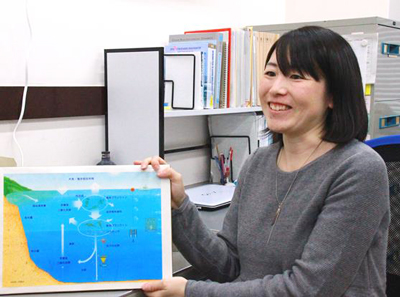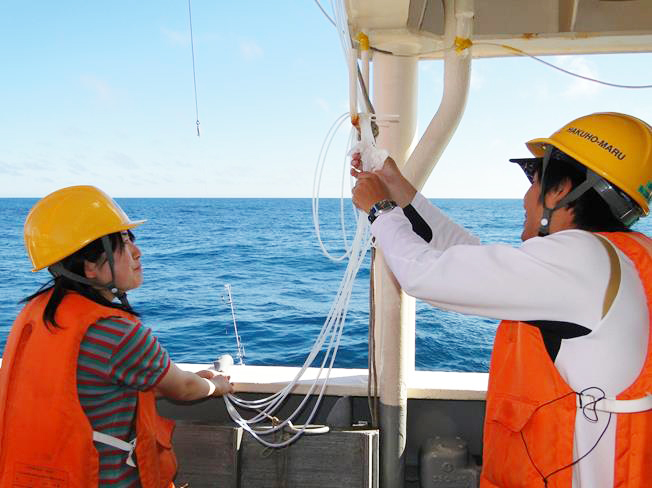TSUKUBA FUTURE
#083 Using the Behavior of Marine Microbes to Understand the Earth's Carbon Cycle
Assistant Professor OMORI Yuko, Faculty of Life and Environmental Sciences

Marine snow, which falls from the upper waters of the sea, might seem somewhat romantic, but in reality it consists of dead microbes and fecal matter. Vast quantities of other organic matter are also dissolved in seawater. It is still unclear what role this organic matter, which is not decomposed by plankton or bacteria, plays in the material cycle. Or whether matter created by sea life influences the climate. Prof. Omori is trying to decipher these dynamic mechanisms.
The sea is said to be a vast depository of carbon dioxide. Phytoplankton use the carbon dioxide present in seawater to photosynthesize, and thus create a range of organic matter such as sugar etc. The phytoplankton are eaten by zooplankton and fish and in turn their dead bodies and fecal matter are broken down by bacteria and other materials before reverting to carbon dioxide. Dead remains which have not decomposed fall as marine snow and collect on the seabed. This is how the dynamic ocean-atmosphere material cycle works.
Prof. Omori began by researching the circulation dynamic of organic matter derived from marine microbes in the marine ecosystem. In addition to the photosynthetic products mentioned earlier, marine organic matter also consists of something known as dissolved organic matter. The carbon content of this dissolved organic matter matches that of terrestrial plants, and plays a vital role as a depository for Earth's carbon. Therefore, it is an important entity in terms of global warming, which is caused by an increase in carbon dioxide in the atmosphere. However, the causes and dynamics of this are still shrouded in mystery.
Dissolved organic matter comes about through phytoplankton photosynthesis. A lot of dissolved organic matter created by photosynthesis is absorbed by bacteria and broken down. According to Prof. Omori, this is 'tasty' organic matter which becomes part of the material cycle. However, most of the dissolved organic matter which exists in the sea is 'unappetizing' organic matter which bacteria are unable to use. Even though large amounts of this 'unappetizing' organic matter remain in the sea for hundreds, if not thousands of years, for many years it was not known what organisms create them. Research carried out by those such as Professor Takeo Hama, who was also Prof. Omori's teacher, has shown that dissolved organic matter might be a product of bacterial metabolism. In other words, in addition to their role as decomposers of organic matter, bacteria also generate 'unappetizing' organic matter. This is a fascinating discovery, very befitting of the sea that conceals so many mysteries. Prof. Omori carries out experiments in 400 liter and 20 liter seawater tanks at the Shimoda Marine Research Center in order to investigate the behavior of the dissolved organic matter generated by bacteria in the vast sea.

"I am always amazed by the enormous role these tiny creatures play," says Prof. Omori.
After finishing a doctorate at the University of Tsukuba, Prof. Omori was a postdoctral researcher for a time at the National Institute for Environmental Studies, where she became involved in research into interactions between the ocean and the atmosphere. She investigated a substance called dimethyl sulfide which is generated by phytoplankton and bacteria. Dimethyl sulfide smells the particular aroma of the seashore. As it does not easily dissolve in seawater, dimethyl sulfide are released into the atmosphere, oxidized and eventually turned into sulphates. These sulphates are particles which are said to lead to the formation of clouds. In other words, organic matter formed by tiny microbes in the sea affects Earth's climate. Prof. Omori and her team boarded a research and observation ship and developed and utilized a new methodology for the measurement of the amounts of dimethyl sulfide released from the ocean into the atmosphere. She then compared her own measurements with existing estimated values calculated using traditional methodologies, and has thus contributed to improvements in the quality of climate system models.
Prof. Omori became interested in the sea when she attended a summer school in Miyakejima Island as a second year junior high school student. After the entertaining sea and mountain field trips led be marine biologists, she realized she was absolutely fascinated by the sea. That was the year before the large eruption on Miyakejima, an event she says caused her to romanticize her memories. When she had made up her mind to research sea creatures at university, she found out that there was a Biological Sciences course in which one could study Aquatic Ecology at the University of Tsukuba. This is how Prof. Omori met Prof. Hama. Her dream of traveling to the Antarctic Ocean has yet to materialize, but nevertheless she has participated in numerous enjoyable hydrography cruises on the Pacific Ocean. She continues to be amazed by the work tiny creatures do in the vast ocean, work observed though onboard surveys and incubation experiments carried out in the lab.

Preparing the observation device to measure the sea-to-air flux of dimethyl sulfide. The tip of the device can be seen on the far side of the barrier.
Article by Science Communicator at the Office of Public Relations



